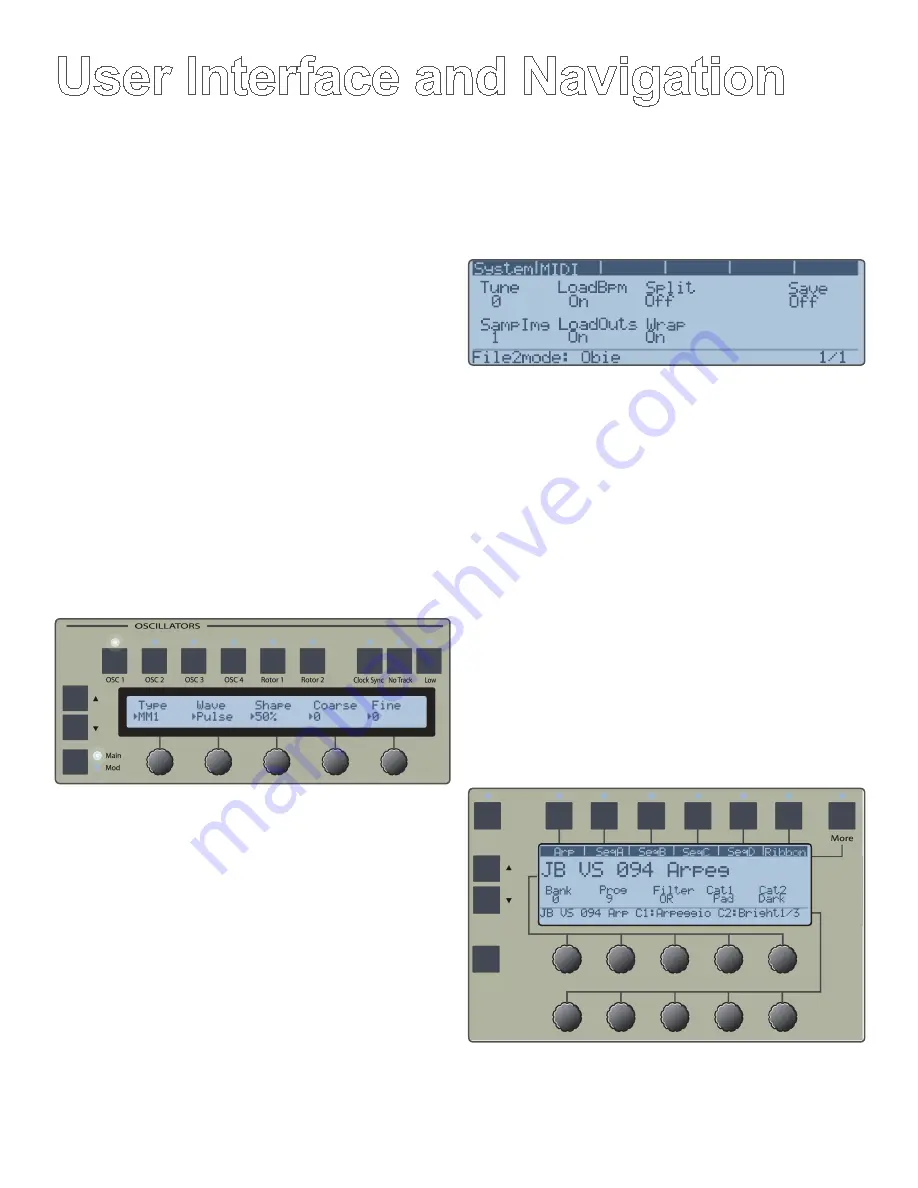
GRAPHIC DISPLAY | 13
GENERAL NAVIGATION
General Navigation
This section introduces some very important con-
cepts that will help you easily dive into the depths
of Solaris. It’s well worth your time to read this
chapter!
The Solaris is organized so that you can get to a number of
parameters rather quickly. That’s why I’ve decided to use
six displays: five text displays and one Graphic Display.
Even so, with over 1200 parameters, inevitably there is
going to be the need to ‘page’ the displayed parameters. All
synthesizers have several basic sections to create sound;
the five text displays are used to handle the parameters for
seven of these sections (2 of the 5 displays are ‘shared’).
These sections are: Oscillators, LFOs, Mixers/InsertFX,
Filters/VCAs, and Envelopes. The sixth display is called the
graphics (gfx) display, and is used to handle all remaining
parameters of the instrument.
Text Displays (x5)
Figure 9. Typical Text Display
Main Mode and Mod Mode
Figure 9 shows the layout of a text display, this one from
the Oscillators section. For each of the text display sec-
tions, you have 1 pair of buttons stacked vertically. The pair
of buttons to the left of the displays are
Inc/Dec
buttons.
Below those is the sub-group toggle button. The upper
subgroup is called
Main
, the lower one
Mod
. For each
section, you will find general settings under the
Main
pages, and all possible modulation to that group under the
Mod
pages. Typically there are 2
Main
pages and 4
Mod
pages per group, although this does vary a bit.
Throughout this manual, we will refer to a panel’s
Main Mode and Mod Mode. Those modes, or sets of
menus, are access by the sub-group toggle button
(or by using Wrap, as described below).
There are several ways to step through the pages. The
user can decide to step through all pages with the
Inc/Dec
buttons, and then stop at the end, or to be able to continu-
ously ‘wrap around’ from the last to the first page.
Figure 10. System Tab in Graphic Display
This function is called Wrap, and is set on the System tab,
as shown in Figure 10. The System tab is found in the
softkeys sets on the graphic display by pressing the
More
button a few times. Also here is Split, which allows you to
stay within the boundaries of either the Main or the Mod
sub-group. This is handy when you want to switch quickly
back and forth between two related pages, say Shape in
the Main pages and a modulation of Shape in the Mod
pages.
If you want to quickly reach the topmost page of any object
(Oscs, LFOs, Mixers, Filters, VCAs, Envelopes), just quick
-
ly ‘double click’ that object’s select button. You can also use
the object select buttons to do a “copy & paste” operation -
simply hold down the button of the object you want to copy
until it starts blinking, and then select the button where you
want to paste the data. Of course, this only works with like
objects - LFOs to other LFOs, Filters to Filters, etc.
Graphic Display
Figure 11.
Home
Shift
Graphic Display
The center section with the graphic display is the softkey
functional display area. It also has a Preset Mode when
the Preset switch is on (at the top of the numeric keypad
User Interface and Navigation
Summary of Contents for Solaris
Page 1: ...User Guide Version 1 ...












































